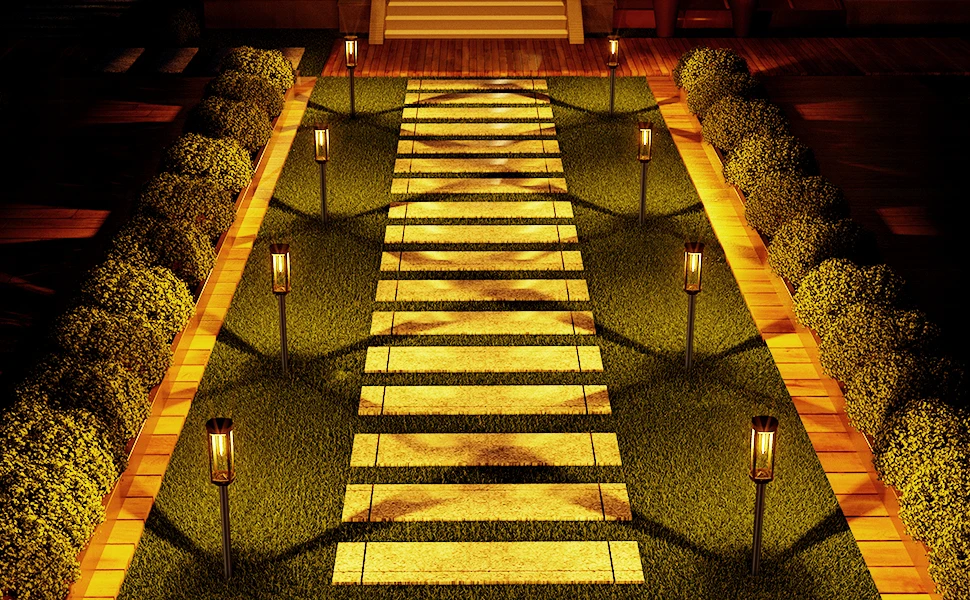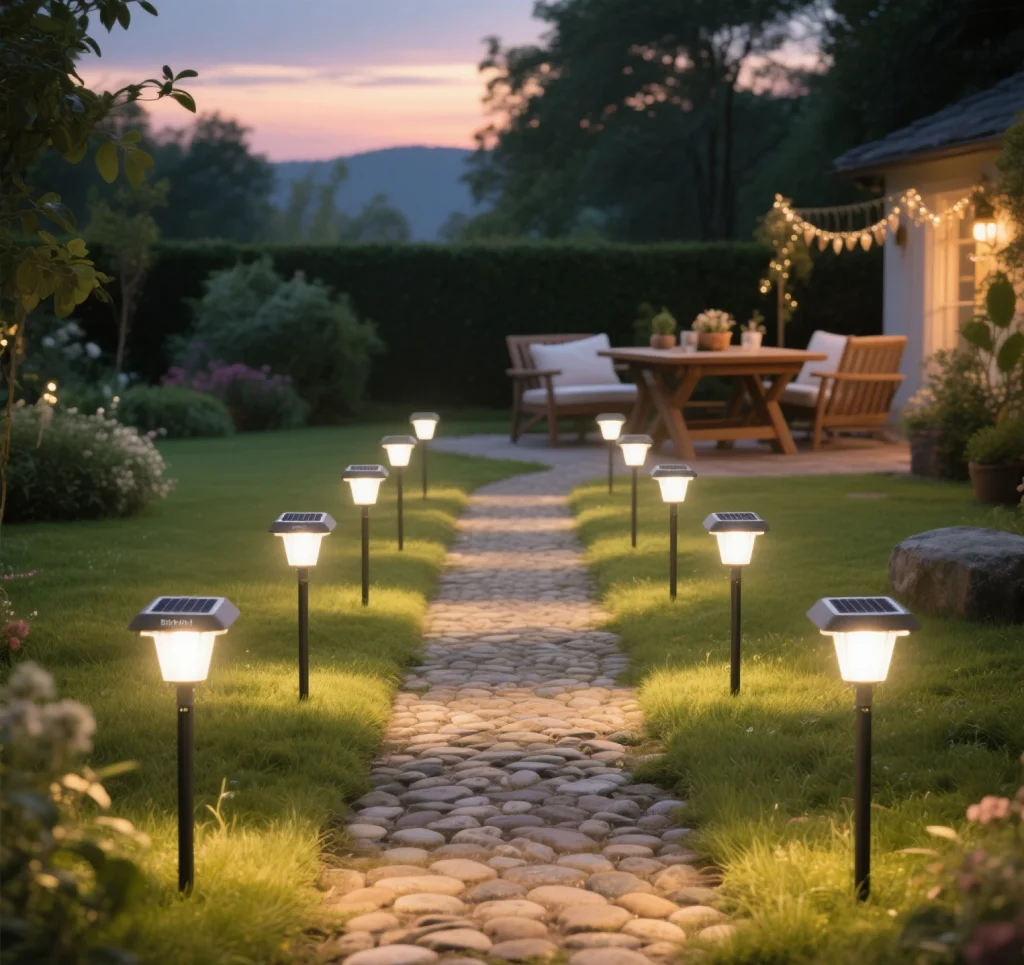Rain gardens are gaining popularity across the U.S. as a sustainable landscaping solution, particularly among landscape designers and eco-conscious homeowners. These gardens manage stormwater runoff while supporting native plants and local ecosystems. However, illuminating a rain garden without disrupting its ecological balance requires careful planning. Solar lighting offers an environmentally friendly, low-maintenance solution that enhances the beauty and functionality of rain gardens. This article explores aquatic solar lights, eco-friendly material lamp bodies, and light-and-rain-sensing dual-mode systems, tailored for rain gardens. We’ll also provide a diagram illustrating how solar lighting integrates with wetland ecosystems, ensuring minimal environmental impact.

Why Solar Lighting for Rain Gardens?
Rain gardens are designed to capture and filter rainwater, reducing runoff and supporting biodiversity. Traditional lighting systems, with their wiring and energy demands, can disrupt soil structure and local wildlife. Solar lighting, powered by renewable energy, eliminates these concerns while offering practical and aesthetic benefits. For landscape designers and homeowners, solar lighting enhances rain garden functionality—such as monitoring water levels during storms—while aligning with sustainability goals. Its easy installation and low maintenance make it ideal for eco-friendly landscapes.
Aquatic Solar Lights: Illuminating Water Features
Rain gardens often include shallow water zones to support aquatic plants like sedges or rushes. Aquatic solar lights, with an IP68 waterproof rating, are designed to be submerged in these areas, providing safe and effective illumination without harming the ecosystem.
- Waterproof Design: Aquatic solar lights are sealed to withstand submersion in shallow water, making them perfect for illuminating waterlogged areas of a rain garden. Their IP68 rating ensures durability against rain, splashes, and prolonged exposure to moisture.
- Plant-Friendly Illumination: These lights use soft, warm LEDs to highlight aquatic plants without disrupting their growth cycles. Adjustable brightness settings allow designers to create subtle glows that enhance nighttime aesthetics.
- Floating or Anchored Options: Some aquatic solar lights float freely, while others can be anchored to the garden bed, offering flexibility for various rain garden layouts.
When selecting aquatic solar lights, choose models with corrosion-resistant materials like stainless steel or UV-resistant plastics to ensure longevity in wet environments. Position solar panels on nearby dry areas, such as garden edges, to maximize sunlight exposure.
Eco-Friendly Material Lamp Bodies: Sustainable Design
Sustainability is at the heart of rain garden design, and eco-friendly material lamp bodies ensure that lighting choices align with this ethos. Made from materials like bamboo or biodegradable plastics, these lamp bodies minimize environmental impact.
- Natural Materials: Bamboo-based eco-friendly material lamp bodies are renewable, lightweight, and blend seamlessly with the organic aesthetic of rain gardens. Their natural finish complements native plants and earthy tones.
- Biodegradable Plastics: Some lamps use plastics derived from plant-based sources that decompose naturally, preventing soil or water contamination. These materials are ideal for eco-conscious homeowners concerned about long-term environmental impact.
- Durability: Despite their eco-friendly composition, these lamp bodies are treated to resist moisture and UV damage, ensuring they withstand the damp conditions of rain gardens.
When incorporating eco-friendly material lamp bodies, designers should ensure the solar panels are discreetly integrated to maintain the garden’s natural look. Regular cleaning of panels prevents dirt buildup, which can reduce charging efficiency in muddy rain garden environments.
Light-and-Rain-Sensing Dual-Mode Systems: Smart Functionality
Rain gardens are dynamic spaces, with water levels fluctuating based on weather conditions. Light-and-rain-sensing dual-mode systems adapt to these changes, providing enhanced brightness during rain to aid in monitoring water accumulation.
- Smart Sensors: These systems combine light sensors (activating at dusk) with rain sensors that detect precipitation and boost brightness. This feature is invaluable for homeowners monitoring rain garden performance during storms.
- Energy Efficiency: Light-and-rain-sensing dual-mode systems use low-power LEDs, ensuring long-lasting illumination even during cloudy, rainy periods. Some models include battery backups for consistent performance.
- Customizable Settings: Designers can adjust sensitivity levels to balance energy use and illumination needs, ensuring minimal disruption to wildlife while maintaining functionality.
For optimal performance, place the rain sensor in an open area of the rain garden to accurately detect precipitation. Regularly check sensor calibration to ensure responsiveness, especially in regions with frequent storms.
Rain Garden Lighting and Plant Symbiosis Diagram
To illustrate how solar lighting integrates with rain garden ecosystems, the following conceptual diagram outlines a low-impact design:
- Core Components:
- Aquatic solar lights placed in shallow water zones to highlight aquatic plants like irises or cattails, using warm LEDs to avoid disrupting photosynthesis.
- Eco-friendly material lamp bodies (bamboo or biodegradable plastic) along garden edges, illuminating native perennials like milkweed or coneflowers.
- Light-and-rain-sensing dual-mode systems positioned centrally to monitor water levels, with solar panels on elevated stands for maximum sunlight exposure.
- Symbiotic Design:
- Lights are angled to avoid direct glare on water surfaces, reducing disturbance to nocturnal wildlife like frogs or insects.
- Solar panels are placed on permeable surfaces to prevent runoff interference, ensuring the rain garden’s drainage function is unimpaired.
- Low-intensity LEDs (below 3000K) minimize impact on plant circadian rhythms, supporting healthy growth cycles.

This design ensures that solar lighting enhances the rain garden’s aesthetic and functional roles while maintaining ecological harmony.
Practical Tips for Rain Garden Solar Lighting
To maximize the effectiveness of solar lighting in rain gardens, consider these actionable tips:
- Optimize Solar Panel Placement: Position panels in areas with at least 6–8 hours of direct sunlight daily, such as elevated stands or garden borders, to ensure efficient charging. In shaded rain gardens, use detachable panels that can be placed in sunnier spots.
- Choose Low-Impact Designs: Select aquatic solar lights and eco-friendly material lamp bodies that blend with the garden’s natural aesthetic, avoiding overly bright or industrial-looking fixtures.
- Monitor Water Levels: Use light-and-rain-sensing dual-mode systems to track water accumulation during heavy rain, helping homeowners assess drainage performance and prevent flooding.
- Regular Maintenance: Clean solar panels and lamp bodies monthly to remove mud or debris, which is common in rain gardens. Check waterproof seals on aquatic solar lights to prevent leaks.
- Wildlife Considerations: Use warm-toned LEDs and avoid over-illumination to minimize disruption to pollinators, amphibians, or other rain garden inhabitants.
Case Study: Successful Rain Garden Lighting Projects
Real-world examples demonstrate the impact of solar lighting in rain gardens:
Case Study 1: Urban Rain Garden in Seattle
A landscape designer in Seattle integrated aquatic solar lights and eco-friendly material lamp bodies into a residential rain garden to manage stormwater from a nearby rooftop. The bamboo-based lamps complemented native ferns and sedges, while light-and-rain-sensing dual-mode systems ensured visibility during frequent Pacific Northwest rains. The project reduced runoff by 70% and was praised by local environmental groups for its sustainable design.
Case Study 2: Suburban Eco-Retreat in Minnesota
A homeowner in Minnesota transformed their backyard into a rain garden featuring aquatic solar lights in a shallow pond area and eco-friendly material lamp bodies along pathways. The light-and-rain-sensing dual-mode systems helped monitor water levels during spring storms, preventing overflow. The garden became a local showcase for sustainable landscaping, attracting visits from community gardening clubs.
Conclusion
Solar lighting is a game-changer for rain gardens, offering landscape designers and eco-conscious homeowners a sustainable way to enhance beauty and functionality. Aquatic solar lights illuminate water features, eco-friendly material lamp bodies ensure minimal environmental impact, and light-and-rain-sensing dual-mode systems provide smart, adaptive illumination. By following low-impact design principles and leveraging the symbiotic diagram provided, you can create a rain garden that supports biodiversity while shining brightly. Whether managing stormwater or showcasing native plants, these solar lighting solutions make rain gardens both practical and picturesque.

Comments